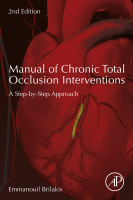Physical Address
304 North Cardinal St.
Dorchester Center, MA 02124

You’re Reading a Preview Become a Clinical Tree membership for Full access and enjoy Unlimited articles Become membership If you are a member. Log in here

You’re Reading a Preview Become a Clinical Tree membership for Full access and enjoy Unlimited articles Become membership If you are a member. Log in here

13.1 Is Chronic Total Occlusion Percutaneous Coronary Intervention for You? Start with why. Simon Sinek Should you embark on the trip of learning chronic total occlusion (CTO) percutaneous coronary intervention (PCI)? This is a challenging question with no easy answer.…

From all that has been discussed in the previous chapters of this book the reader will have already realized that chronic total occlusion (CTO) interventions are among the most complex percutaneous coronary interventions (PCIs). In this chapter we perform a…

11.1 Stent Type Restenosis rates after chronic total occlusion (CTO) stenting can be relatively high. Bare metal stents (BMS) significantly reduce restenosis compared to balloon angioplasty alone, yet the incidence of restenosis and reocclusion remains very high. In the Total…

Radiation skin injury ( Fig. 10.1 ) is a rare complication of any invasive cardiac procedure, but is more likely to occur in the setting of complex procedures, such as chronic total occlusion (CTO) percutaneous coronary intervention (PCI), where large…

9.1 Proximal Cap Ambiguity Online Cases 2 , 5 , 16 , 30 , 32 , 33 , 34 , 45 , 47 , 49 , 51 , 55 , 56 , 69 , 80 , 88 , 93 ,…

8.1 Balloon-Uncrossable Lesions See Online Cases 1 , 5 , 15 , 18 , 27 , 30 , 31 , 47 , 49 , 52 , 53 , 57 , 73 , 82 . Goal Cross the chronic total occlusion…

The optimal approach to chronic total occlusion (CTO) percutaneous coronary intervention (PCI) continues to evolve. Although various CTO crossing techniques have been developed (antegrade wire escalation; antegrade dissection/reentry; and retrograde, as described in Chapter 4, Chapter 5, Chapter 6 ),…

6.1 Historical Perspective The retrograde technique differs from the standard antegrade approach in that the occlusion is approached from the distal vessel, advancing a wire against the original direction of blood flow (i.e., retrograde). The guidewire is advanced into the…